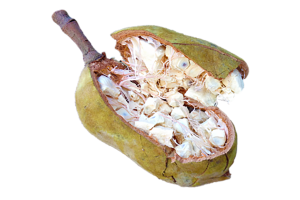
Description:
Baobab is the common name for each of the nine species of tree in the genus Adansonia. Of those nine species, six are native to Madagascar and two to the Arabian Peninsula and mainland Africa and one to Australia. The shape of the Baobab fruit can sometimes be obtuse, oblong-cylindrical or globose and is covered in a velvety yellow-greenish hair. The seeds inside the woody thick outer shell are reniform and embedded in the dry mealy pulp.
Medicinal Properties:
In traditional African medicine, the Baobab fruit pulp, bark, leaves, roots, oil and seeds are commonly used to treat an extensive variety of illnesses. Baobab powder contains soluble fibre, which is great for reducing cholesterol and the risk of heart disease, as well as increasing satiety and stabalising blood sugars. It also contains insoluble fibre, which has been linked to improving bowel health and digestion. Vitamin C is also present in the Baobab fruit, which aids in the reduction of inflammation, ageing and free radicals.
Nutrients & Phytochemicals:
Baobab fruit pulp has been shown to contain a good source of fat, protein and crude fibre. Our Baobab powder contains 25% soluble fibre, 10% insoluble fibre and has a naturally-occurring source of vitamin C, which will offer you 25% of the RDI per 11g serve. The seed and fruit pulp of the Baobab contain excellent sources of potassium, magnesium and calcium along with amino acids such as glutamic acid, aspartic acid and arginine in significant quantities.
Uses For Baobab Fruit/Powder:
- Sprinkled on desserts, yogurt and fruit to add a citrus flavour
- Mixed into smoothies, shakes, juices
- Utilised as a health supplement for a fibre and vitamin C claim
- As a thickening agent in soups or sauces
Did You Know?
- It is thought that some Baobab trees are over 1000 years old as they are able to tolerate high temperatures and long spans of drought
- Baobab trees flower, producing a staminal tube, much like that of a hibiscus with compound leaves
- The fruit of the Baobab trees develop 5-6 months after flowering
- The young leaves of the Baobab tree can be cooked as spinach or dried as a powder for sauces
References:
Sidibe, M and William J.T. (2002) Baobab. Adansonia digitate. International Centre for Underutilised Crops, Southampton, UK. <L.https://books.google.com.au/books?hl=e n&lr=&id=zskefIIlc1IC&oi=fnd&pg=PA5&dq=baobab&ots=IGMdG6mf1u&sig=B0haf8-w2dj-Oqw7BQlNEI5Y704>
Osman, M, 2004, Chemical and Nutrient Analysis of Baobab (Adansonia digitata) Fruit and Seed Protein Solubility, Plant for Food and Humans, vol. 59 pp. 29-33 http://www.baobabdirect.com/newsitems/ChemicalAndNurientAnalysisofBaobabFruitAndSeedProteinSolubility.pdf


